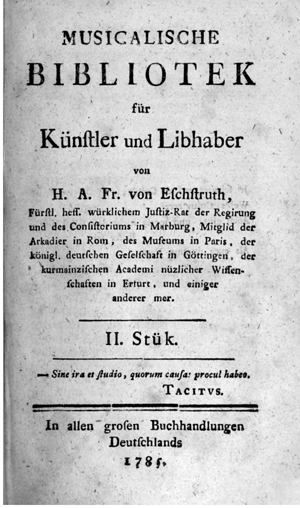Musicalische Bibliothek
Includes:
Prepared by Alexander Staub
Online only (2024)

The Musicalische Bibliothek (RIPM code MBK), which in its second year bore the title Musicalische Bibliotek für Künstler und Libhaber (sic, transcribed from the 1785 masthead), appeared in two parts (one volume) in the years 1784 to 1785. A third part was ready to be printed in 1789 but never appeared. The MBK was edited by Hans Adolph Friedrich von Eschstruth and published by Johann Christian Krieger Jr. (Marburg and Gießen). Eschstruth dedicated the periodical to Duke Karl August of Saxe-Weimar and Eisenach. The editor, who according to his contemporaries was characterized by a pronounced elitism, chose an unusual orthography for the MBK, certainly a visual expression of this tendency.
The two parts comprise about 150 pages each. The first (1784) counts pp. [1]-152, and the second (1785) contains nine unnumbered pages followed by pp. 170-312, after which it breaks off abruptly, the last contribution being incomplete. In addition, the supplements to the first issue appear not to have survived, though announcements are found for two sacred songs by Carl Philipp Emanuel Bach—a Weihnachtslied and a second unidentifiable work, both probably based on Sturm’s Geistliche Gesänge—and a song by Eschstruth himself.
The Musicalische Bibliothek contained eleven sections: I. “Recensionen” (reviews) (as Eschstruth explains in his preface, this section comprises “reiflich erwogene Urteile, Zergliederungen, Verbesserungen von Neuerscheinungen (well-grounded opinions, analyses, improvements of new releases), II. „Widerlegung ungerechter oder irriger Recensionen“ (refutations of unfair or erroneous reviews), III. „Biographien“ (biographies), IV. „Abhandlungen und Vorlesungen“ (essays and lectures - on the advantages of the G clef), V. „Auszüge aus grösren Werken“ (excerpts of larger works), VI. „Berichtigungen und Zusätze zu musicalischen Werken“ (corrigenda and addenda to musical works), VII. „Musicalische Anfragen und Aufgaben“ (musical inquiries and commissions), VIII. „Musicalische Nachrichten und Neuigkeiten“ (musical communications and novelties (e.g., excerpts from letters, announcements), IX. „Anekdoten und Einfälle“ (anecdotes and ideas), X. „Musicalische Gedichte“ (musical poems) and XI. „Ser merkwürdige Stücke“ (remarkable pieces). Sections VI and VII existed only as headings; in the actual issues they were never filled with contents. In the first issue, sections III. and IV. plus sections II. and VIII. in the second (partly) remained empty, containing only a reference that the pertinent material would be published in subsequent issues.
Eschstruth was convinced of the need for a music criticism that was objective and determined by insight, veracity and sincerity—only under these premises would it be possible to maintain quality. In this he meant to be a role model. To eschew the impression of rash or prejudiced judgment, his reviews were thorough and profound, taking up considerable space in the journal. Thus the critical reviews of Johann Nikolaus Forkel’s Musicalischer Almanach für Deutschland auf das Jahr 1784 and Carl Friedrich Cramer’s Magazin der Musik (1783) alone covered 35 and 23 pages respectively. Regarding his reputation as being unprejudiced, Eschstruth even went so far as to publish a harsh review of his journal in full length. In addition he presented a selection of new—and in his eyes groundbreaking—compositions so as to help his readers develop their own aesthetic judgment. (Auto-)biographies and biographical information, precise bibliographic details in the chapter „Nachrichten von Marmor-Säulen, Büsten, Gips-Abdrücken, Kupferstichen und Schattenrissen verschidner Tonkünstler“ (news on marble pedestals and busts, plaster casts, etchings and silhouettes of various musicians) as well as a comprehensive entertainment section with 50 anecdotes on more than 40 pages gave the Musicalische Bibliothek its almanac-like character. The journal combined the fields of information, conservation and entertainment and thus was in the position to attract a large readership. In its short duration it shared the fate of many journals of the time, however.
This RIPM index was prepared from a copy of the journal held by the Bayerische Staatsbibliothek. Many other copies were consulted to find a copy bearing the completion of the second part; unfortunately, none could be found.
